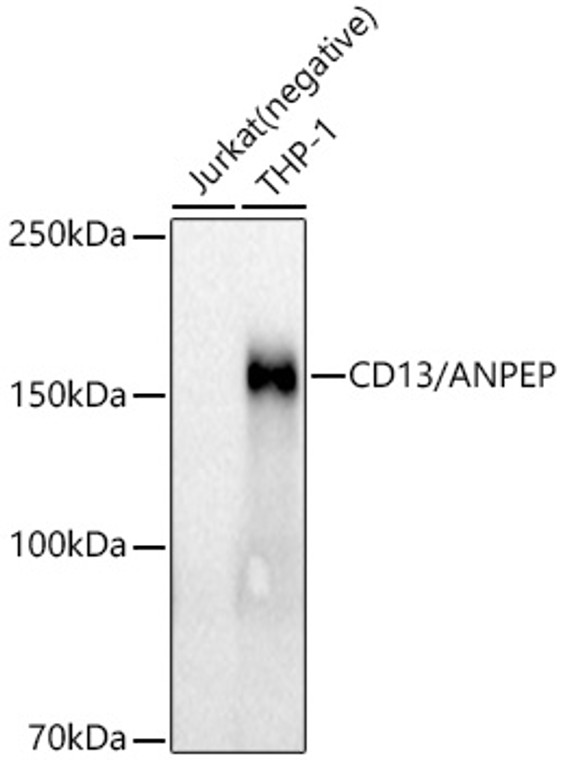| Host: |
Rabbit |
| Applications: |
WB/IHC/FC |
| Reactivity: |
Human |
| Note: |
STRICTLY FOR FURTHER SCIENTIFIC RESEARCH USE ONLY (RUO). MUST NOT TO BE USED IN DIAGNOSTIC OR THERAPEUTIC APPLICATIONS. |
| Short Description: |
Rabbit monoclonal antibody anti-Aminopeptidase N (69-967) is suitable for use in Western Blot, Immunohistochemistry and Flow Cytometry research applications. |
| Clonality: |
Monoclonal |
| Clone ID: |
S4251RM |
| Conjugation: |
Unconjugated |
| Isotype: |
IgG |
| Formulation: |
PBS with 0.05% Proclin300, 0.05% BSA, 50% Glycerol, pH7.3. |
| Purification: |
Affinity purification |
| Dilution Range: |
WB 1:10000-1:40000IHC-P 1:100-1:500FC 1:50-1:200 |
| Storage Instruction: |
Store at-20°C for up to 1 year from the date of receipt, and avoid repeat freeze-thaw cycles. |
| Gene Symbol: |
ANPEP |
| Gene ID: |
290 |
| Uniprot ID: |
AMPN_HUMAN |
| Immunogen Region: |
69-967 |
| Immunogen: |
Recombinant fusion protein containing a sequence corresponding to amino acids 69-967 of human CD13/ANPEP (NP_001141.2). |
| Immunogen Sequence: |
KAWNRYRLPNTLKPDSYRVT LRPYLTPNDRGLYVFKGSST VRFTCKEATDVIIIHSKKLN YTLSQGHRVVLRGVGGSQPP DIDKTELVEPTEYLVVHLKG SLVKDSQYEMDSEFEGELAD DLAGFYRSEYMEGNVRKVVA TTQMQAADARKSFPCFDEPA MKAEFNITLIHPKDLTALSN MLPKGPSTPLPEDPNWNVTE FHTTPKMSTYLLAFIVSEFD YVEKQASNGVLIRIWARPS |
| Tissue Specificity | Expressed in epithelial cells of the kidney, intestine, and respiratory tract.granulocytes, monocytes, fibroblasts, endothelial cells, cerebral pericytes at the blood-brain barrier, synaptic membranes of cells in the CNS. Also expressed in endometrial stromal cells, but not in the endometrial glandular cells. Found in the vasculature of tissues that undergo angiogenesis and in malignant gliomas and lymph node metastases from multiple tumor types but not in blood vessels of normal tissues. A soluble form has been found in plasma. It is found to be elevated in plasma and effusions of cancer patients. |
| Post Translational Modifications | Sulfated. N- and O-glycosylated. May undergo proteolysis and give rise to a soluble form. |
| Function | Broad specificity aminopeptidase which plays a role in the final digestion of peptides generated from hydrolysis of proteins by gastric and pancreatic proteases. Also involved in the processing of various peptides including peptide hormones, such as angiotensin III and IV, neuropeptides, and chemokines. May also be involved the cleavage of peptides bound to major histocompatibility complex class II molecules of antigen presenting cells. May have a role in angiogenesis and promote cholesterol crystallization. May have a role in amino acid transport by acting as binding partner of amino acid transporter SLC6A19 and regulating its activity. (Microbial infection) Acts as a receptor for human coronavirus 229E/HCoV-229E. In case of human coronavirus 229E (HCoV-229E) infection, serves as receptor for HCoV-229E spike glycoprotein. (Microbial infection) Mediates as well Human cytomegalovirus (HCMV) infection. |
| Protein Name | Aminopeptidase NAp-NHapnAlanyl AminopeptidaseAminopeptidase MAp-MMicrosomal AminopeptidaseMyeloid Plasma Membrane Glycoprotein Cd13Gp150Cd Antigen Cd13 |
| Database Links | Reactome: R-HSA-2022377Reactome: R-HSA-6798695 |
| Cellular Localisation | Cell MembraneSingle-Pass Type Ii Membrane ProteinAlso Found As A Soluble Form |
| Alternative Antibody Names | Anti-Aminopeptidase N antibodyAnti-Ap-N antibodyAnti-Hapn antibodyAnti-Alanyl Aminopeptidase antibodyAnti-Aminopeptidase M antibodyAnti-Ap-M antibodyAnti-Microsomal Aminopeptidase antibodyAnti-Myeloid Plasma Membrane Glycoprotein Cd13 antibodyAnti-Gp150 antibodyAnti-Cd Antigen Cd13 antibodyAnti-ANPEP antibodyAnti-APN antibodyAnti-CD13 antibodyAnti-PEPN antibody |
Information sourced from Uniprot.org
12 months for antibodies. 6 months for ELISA Kits. Please see website T&Cs for further guidance















